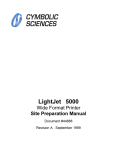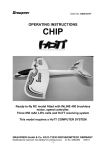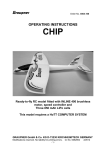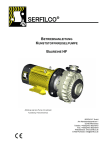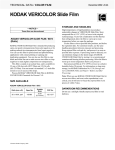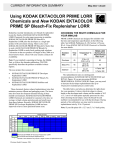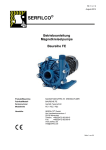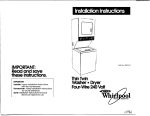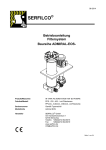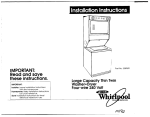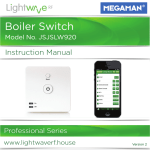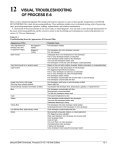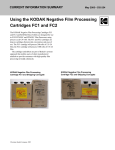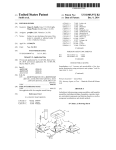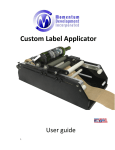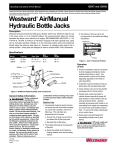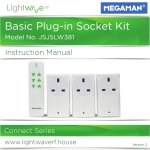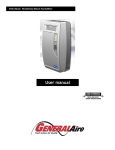Download CIS-269
Transcript
CURRENT INFORMATION SUMMARY July 2009 • CIS-269 Using KODAK EKTACOLOR Digital Developer Replenisher RT in Roller-Transport Processors KODAK EKTACOLOR Digital Developer Replenisher RT is designed for use in rollertransport processors using Process RA-4. The performance features of this developer are: Primarily designed for digitally exposed output media processed in roller transport processors Produces extra-high D-max for intense blacks, with the most significant impact on processed KODAK PROFESSIONAL ENDURA Transparency and Clear Display Materials Formulated for robust performance in processors operating in a wide range of utilizations. These features make EKTACOLOR Digital Developer Replenisher RT a recommended alternative to regular EKTACOLOR Developer Replenisher RT in commercial pro lab applications. Product Change Kodak is pleased to announce an improved formulation of KODAK EKTACOLOR Digital Developer Replenisher RT. This improved formulation features the same robust performance with greatly reduced potential for crystal formation in the concentrates when stored or transported at low temperatures. The improved formulation will be available on a stock turnover basis beginning in mid-August, 2009. There will be a catalog number change for the new formulation of Digital Developer Replenisher RT. See the following table for product catalog numbers. Product Description EKTACOLOR Digital Developer Replenisher RT, Part A , 189 L/50 gal EKTACOLOR Digital Developer Replenisher RT, Part B, 189 L/50 gal Current Product Catalog Number Replaced by New Formulation Catalog Number 1290477 8212185 1487982 8531691 Comments: - The new formulation will not require a change in mixing procedures. - Replenishment rate for the new formulation is same as for current product. - The new Part A concentrate will be slightly darker in visual appearance, having an orange/amber color as opposed to the light yellow of the current product. IMPORTANT: Do not intermix the Part A and B concentrates of the new formulation of KODAK EKTACOLOR Digital Developer Replenisher RT with the older product. When you convert to the new formulation of product, you must convert both Part A (8212185) and Part B (8531691). Inventory management during this conversion is critical. It is NOT necessary to discard mixed replenisher made from the older product. The mixed replenisher from the new product can be added on top of existing replenisher in the replenisher storage tanks. ©Eastman Kodak Company, 2009 Steps and Conditions Use the processing steps and conditions in Table 1 for processing KODAK PROFESSIONAL SUPRA ENDURA VC Digital, ULTRA ENDURA, ULTRA ENDURA High Definition, and ENDURA Metallic VC Digital Papers in rollertransport processors. See Table 3 for replenishment rates. To process KODAK PROFESSIONAL ENDURA Transparency and Clear Display Materials, use the steps and conditions in Table 6. See Table 3 for replenishment rates. Table 1 Processing Steps and Conditions for Process RA-4—Roller-Transport Processors Solution/Step EKTACOLOR Digital Developer Replenisher RT EKTACOLOR RA Bleach-Fix and Replenisher§ Wash¶ Dry Time* sec Temperature °C (°F) 45 35.0 ± 0.3‡ (95.0 ± 0.5) 45 30 to 36 (86 to 96) 90 As needed Comments Recirculate and filter. Use precise temperature control. Use squeegees at tank exit. Recirculate and filter. Use squeegees at tank exit. 30 to 40 (86 to 104) Not over 96 (205) — — *Immersion time plus crossover time to the next tank. Developer time range is 44 to 48 seconds. Minimum times for other solutions can be one second less than the normal times. Longer than normal times should cause no adverse effect other than reducing the benefit of rapid access. For best results, use the recommended times with crossover times of 6 seconds or less. If the crossover time is longer than 6 seconds, the paper or material must be in the developer tank for at least 40 seconds. ‡ Check the developer temperature frequently with an accurate thermometer. § You can use EKTACOLOR RA Bleach-Fix and Replenisher NR if your processor utilization is at least 15 percent. ¶ Where water conservation is required, you can replace the wash with a stabilizer (see Washless Option Table 2—Preparing Replenisher Solutions Mixing KODAK EKTACOLOR Digital Developer Replenisher RT Component KODAK EKTACOLOR Digital Developer Replenisher RT is supplied in separate Part A and Part B flexible containers that will make 189 litres (50 gallons) of mixed replenisher. Table 2 summarizes the instructions for mixing replenisher. Start with approximately 132 litres (35 gallons) of water at a temperature between 21º and 37º Celsius (70º to 100º Fahrenheit). With stirring, add the entire contents of Part A, then stir for two minutes. Follow by adding the entire contents of Part B, then add enough water to equal a total volume of 189 litres (50 gallons). Stir until completely mixed – approximately 5 minutes. Avoid vigorous stirring that allows air into the solution, and avoid stirring for over 5 minutes to avoid unnecessary oxidation. Store the developer replenisher in a tank with a floating lid and a tank cover to reduce evaporation and decomposition. Water EKTACOLOR Digital Developer Replenisher RT, Part A EKTACOLOR Digital Developer Replenisher RT, Part B Volume per one Litre of Replenisher 800 mL 100 mL 100 mL Follow the mixer manufacturer’s recommendations to accurately set up the mixing routine. Following the addition of each of the two parts, briefly rinse the delivery funnel with water so that the two concentrates do not come into direct contact. The total water from the initial delivery and the water from the rinses should total 800 mL for each litre mixed. Note: Carefully observe that the mixing reservoir is completely emptied before the next mix is made. If there is residual mixed replenisher and there is no compensation for it, insufficient water may be added; the result of insufficient water is an overconcentrated replenisher. If the replenisher becomes significantly overconcentrated, precipitates may form in the mixed replenisher tank. An alternative method of mixing solution is to use an automatic mixer that automatically mixes the replenisher and pumps it to a holding tank. Carefully calibrate the delivery of the concentrates and the water according to Table 2. 2 Replenishment Rates Wash and Stabilizer Replenishment Rate—Use The replenishment rates given in Table 3 are starting-point recommendations only. Actual rates depend on the type of processor, the paper or material processed, and the rate of evaporation and oxidation. If you process several products, use an average rate based on the product mix, and adjust it as needed according to control-plot results. Avoid overcontrolling replenishment rates. Rate changes are likely to be small, and you may not see the full effect of changes for several weeks. four countercurrent plumbed wash tanks, if possible. If you use fewer wash tanks, increase the wash rate accordingly. For the recommended rates for the number of wash tanks, see Table 4. Adjust the wash-water rate for the maximum paper load processed, and then operate at this rate. Do not use average rates. Table 4 Number of Final Wash Tanks 1 2 3 4 Table 3 KODAK PROFESSIONAL Paper or Material SUPRA ENDURA VC Digital ULTRA ENDURA ULTRA ENDURA High Definition ENDURA Metallic VC Digital ENDURA Transparency Display ENDURA Clear Display Developer Replenishment Rate mL/m2 and (mL/ft2) Final Wash Rate mL/m2 (mL/ft2) 10,800 (1000)* 6460 to 10,800 (600 to 1000) 4300 to 10,800 (400 to 1000) 2150 to 10,800 (200 to 1000) * If your processor has only one wash tank, use a wash rate of at least 10,800 mL/m2 (1000 mL/ft2). You may need to make other processor modifications to minimize the effect of bleach-fix carryover, because this rate may provide only a marginal safety factor. 174(16.2) 194 (18) 194 (18) Washless Option If your water supply is limited, you can use KODAK EKTACOLOR PRIME Stabilizer and Replenisher LORR in place of a wash. Use temperature-controlled, countercurrent-flow, filtered tanks that have a recirculation rate of 0.40 to 0.65 tank volumes per minute. If the recirculation or replenishment rate is too low, biological growth and precipitates may form and require frequent solution changes and tank cleaning. The stabilizer time and temperature are the same as for wash water. The stabilizer replenishment rate depends on the number of tanks (see Table 5). This information applies only to roller-transport processors. 174 (16.2) 495 (46) 495 (46) Bleach-Fix Replenishment Rate—The starting replenishment rate for EKTACOLOR RA BleachFix and Replenisher for KODAK PROFESSIONAL Papers is 215 mL/m2 (20 mL/ft2). For ENDURA Transparency and Clear Display Materials, the starting bleach-fix replenishment rate is 495 mL/m2 (46 mL/ft2). Do not use EKTACOLOR RA Bleach-Fix and Replenisher NR in roller-transport processors unless the processor utilization is at least 15 percent. The starting replenisher rate for EKTACOLOR RA Bleach-Fix and Replenisher NR for KODAK PROFESSIONAL Papers is 54 mL/m2 (5 mL/ft2). Do not use EKTACOLOR RA Bleach-Fix and Replenisher NR with Display Materials. Bleach-fix regeneration is not recommended for roller-transport processors. Table 5—Replenishment Rates for KODAK EKTACOLOR PRIME Stabilizer and Replenisher LORR KODAK PROFESSIONAL Paper or Material SUPRA ENDURA VC Digital ULTRA ENDURA ULTRA ENDURA High Definition ENDURA Transparency ENDURA Clear 3 Number of Countercurrent Flow Tanks 2 3 4 mL/m2 (mL/ft2) 780 (72) 390 (36) 195 (18) 1560 (144) 780 (72) 390 (46) PROCESSING KODAK PROFESSIONAL ENDURA TRANSPARENCY AND CLEAR DISPLAY MATERIALS See Tables 3, 4, and 5, and the instructions under Bleach-Fix Replenishment Rate above for replenishment rates for these materials in rollertransport processors. Although you can use the same processing chemicals for KODAK PROFESSIONAL ENDURA Transparency and ENDURA Clear Display Materials as for papers and print materials designed for Process RA-4, longer processing times and higher replenishment rates are required because these materials have thicker emulsions. Note that although there is a time range of 110 to 120 seconds, the 120-second time is highly recommended for the best performance. The longer time will significantly reduce variability, especially in the yellow record. The variability can be caused, for example, by non-uniform agitation or low replenishment for high-density images. Table 6 gives the steps and conditions for processing these display materials in rollertransport processors using Process RA-4. You can also use these conditions to process display materials in continuous processors; however, they are usually processed in roller-transport processors because of the inconvenience of rethreading a continuous processor. Table 6—Processing Steps and Conditions for Process RA-4—KODAK PROFESSIONAL ENDURA Transparency, and ENDURA Clear Display Materials Solution/Step Time* sec Temperature† °C (°F) EKTACOLOR Digital Developer Replenisher RT 110 - 120‡ 35.0 ± 0.3 (95.0 ± 0.5) EKTACOLORRA RA Bleach-Fix and Replenisher§ 110 - 120¶ 30 to 36 (86 to 96) Wash** 220 - 240¶ Dry As needed 30 to 40 (86 to 104) Not over 96 (205) Comments Recirculate and filter. Use precise Temperature control. Use squeegees at tank exit. Recirculate and filter. Use Squeegees at tank exit. — — * Immersion time plus crossover time to the next tank. † Check the developer temperature frequently with an accurate thermometer. ‡ For Display Materials, the longer 120 sec developer time is recommended. § Do not use EKTACOLOR RA Bleach-Fix and Replenisher NR with Display Materials. ¶ For best results, use the recommended times with a crossover time of 6 seconds or less. ** Where water conservation is required, you can replace the wash with a stabilizer (see Washless Option in Kodak Publication Z-130, Using KODAK EKTACOLOR Chemicals). To calculate the aim values, read the Status A reflection densities (R, G, B) from each step (BP, HD, LD, D-min) of the supplied reference strip, then apply the correction factors. To obtain the HD-LD aim value, subtract the corrected LD densities from the corrected HD densities. Process Monitoring Professional Control Strips / Process RA-4 You can use KODAK PROFESSIONAL Pro Strips Color Negative Paper Control Strips, Process RA-4 (box of 50, CAT No. 129 8587) to monitor and help maintain process performance. For instructions on processing control strips, see the user’s manual for the printer. For information on the use and diagnostic features of the control strips, see KODAK Publication No. Z-130, Using KODAK EKTACOLOR Chemicals, Section 8, “Process Monitoring and Troubleshooting with KODAK PROFESSIONAL Pro Strips.” Kodak publications are described and available at www.Kodak.com/go/photochemicals. Select Technical Resources to find Processing (Z) Manuals To calculate control-strip aim values for process monitoring, use correction factors that are on the envelope of the reference strip that is packaged with your specific control strip code. Use the correction factor set labeled: EKTACOLOR Digital Developer Replenisher RT. 4 Filtration Preparation of Fresh Tank Mix using KODAK EKTACOLOR Digital Developer Replenisher RT Processing solutions and wash water may contain some insoluble materials. If you don’t filter out these materials, they can stick to the paper, tank walls, rollers, and solution lines, and may damage the paper. Usually, filters with a porosity of 10 to 30 microns are effective for solutions and wash water. For incoming water supplies, use filters with a porosity of 15 microns. You can prepare a fresh working tank mix for your processor using the mix volumes in Table 11. You may want to reduce the amount of EKTACOLOR RA Developer Starter and then add additional starter as needed to reach the process aim. This avoids overshooting the amount of starter and a low process activity level. The fresh tank may produce process control results that are slightly high in red and green speed, low in blue speed, and low in contrast. The process will season to the adjusted control strip aim when the new replenisher is used. You can use the following filter materials with processors that use EKTACOLOR Chemicals: • bleached cotton • cellulose with phenolic-resin binder • fiber glass with phenolic-resin binder • polypropylene • spun polypropylene • viscose rayon with phenolic-resin binder (do not use in the developer) • activated carbon Table 11 Component Water EKTACOLOR Digital Developer Replenisher RT KODAK EKTACOLOR RA Developer Starter Volume to make one Litre of Tank Solution 275 mL 700 mL Polypropylene is the most acceptable filter-core material and one of the least expensive. This material has no photographic effect, but the surfactants used to produce the polypropylene yarns may have an effect on your process. Therefore, monitor your process carefully when you first change filters. Replace filters weekly for developers and every two weeks for other solutions. 25 mL LOW UTILIZATION When a processor is used for a small percentage of its actual capacity, the processing solutions can be affected and yield less than optimum results. At this time, there are no recommendations for low-utilization operation with KODAK EKTACOLOR Digital Developer Replenisher RT. Use sufficient developer at a rate where the volume of replenisher used in two weeks is at least equivalent to the developer tank volume. To reduce oxidation further, turn off the transport drive except during processing. Install a standby switch that allows you to turn off the transport drive without shutting down the recirculation pumps and temperature control. Use of Activated-Carbon Filters to Remove Stain—In roller-transport processors, a build-up of oxidized chemicals in the developer tank solution can stain prints. To remove these oxidized chemicals and prevent staining, install an activated-carbon filter. You will see a significant stain reduction within 24 hours. The life of the filter cartridge depends on the amount of oxidation products that are treated and the size of the processor tank; however, typical length of use is about 14 days with a 75 litre (20gallon) tank. Note: Do not use KODAK EKTACOLOR RA Developer Additive. It is not compatible with KODAK EKTACOLOR Digital Developer Replenisher RT. To reduce the possibility of contamination from the filter, pre-soak it in a small amount of developer replenisher for 24 hours before you install it. Discard the developer used for the presoak. You can use the following filters: 5 Filter Manufacturer or Distributor Polysales Filter Model No. PS-232-9.8 109 Safe Handling of Photographic Chemicals Seneca Tec, Inc. Despatch Drive East Rochester, NY Handle all chemicals carefully. When you mix solutions, wear goggles or a face shield, a protective apron, and protective gloves made from neoprene or nitrile rubber. Clean protective clothing after use to remove any chemical residue that can cause contamination. For more information about potential health hazards and safe handling of specific Kodak chemicals, see the product label and the Material Safety Data Sheet (MSDS) for the chemical. MSDSs also provide regional contact information. MSDSs are available on the Kodak website at www.Kodak.com/go/photochemicals. Select Technical Resources to find Material Safety Data Sheets. 14445 (585) 381-2645 Serfilco Filter Model No. SFC-10W-carbofyne 60062 Serfilco, Inc. 1777 Shermer Road Northbrook, Illinois (847) 559-1777 Serfilco Europe Ashburton Road West Trafford Park Manchester, M17 1RW, England 0161-872-1317 Filter Micro-Carbon Model No. C9, 75P-W5 Trumpler Clancy Inc. 34 E. Main Street Hamburg, NY 14075 (585) 649-9330 Note: The contents of this publication are subject to change. To be sure you have the most up-to-date publication, check www.kodak.com/go/photochemicals; select Technical Resources to find Current Information Summaries. Consumer Digital Group EASTMAN KODAK COMPANY • ROCHESTER, NY 14650 Using KODAK EKTACOLOR Digital Developer Replenisher RT in RollerTransport Processors KODAK Publication No. CIS-269 Kodak, Kodak Professional, Edge, Ektacolor, Endura, , Prime, Royal, Supra, and Ultra are trademarks of Eastman Kodak Company. 6 Minor 7-09






